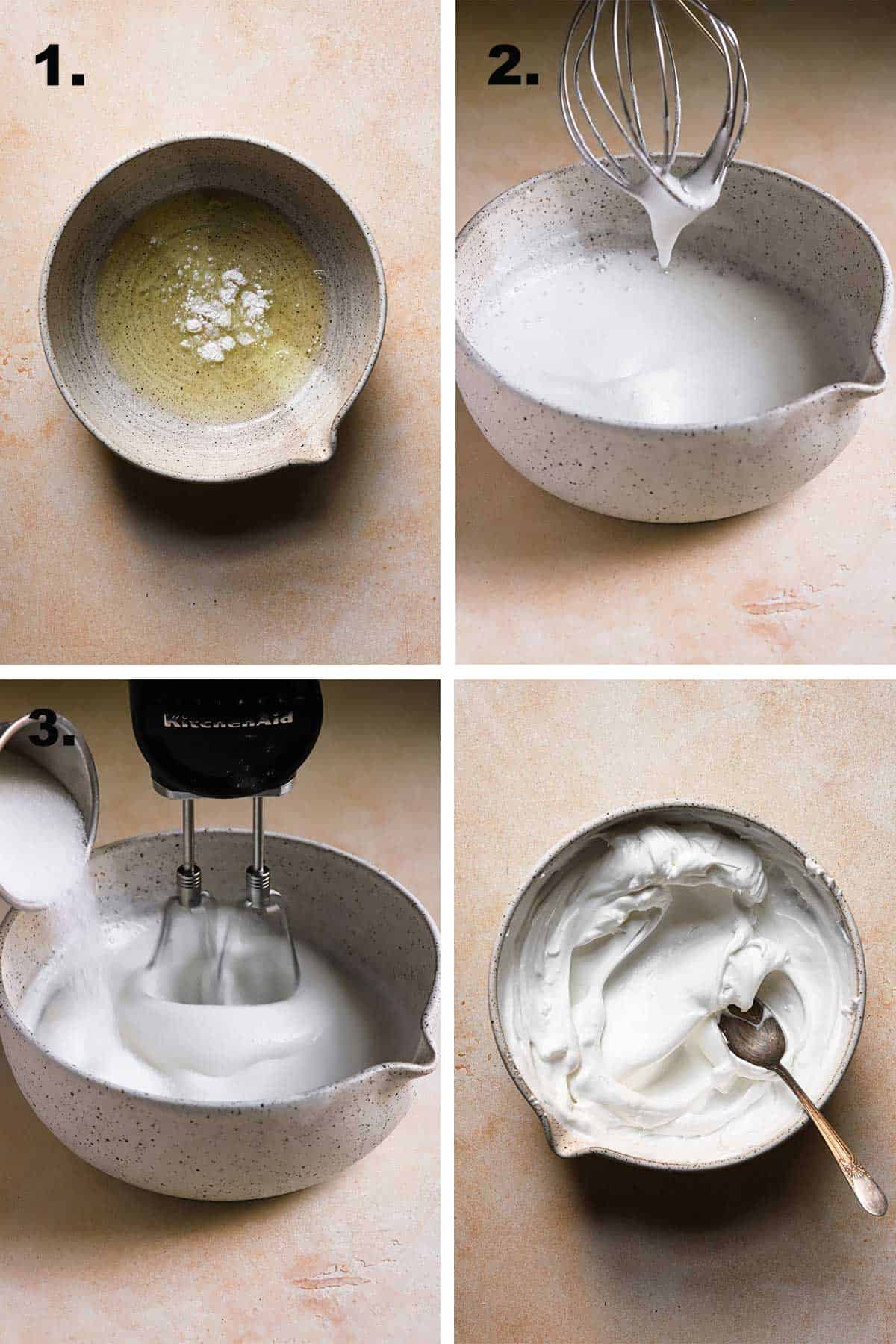Last updated on April 29th, 2024.
Meringue is a culinary wonder that has the power to transform simple egg whites and sugar into delicate, airy, foamy confections that are as versatile as they are delicious. Whether you want to create a stunning pavlova, top a pie with pillowy peaks, or make delightful meringue cookies, knowing how to make meringue is a fundamental skill for any home baker.

What is Meringue?
Meringue is a fundamental component in the world of desserts, and it’s crucial to understand its essence before diving into the kitchen. At its core, it is a mixture of whipped egg whites and sugar. The magic happens when these simple ingredients are transformed into a voluminous, stable foam that can be used in various culinary creations.
For the Baking Science enthusiasts among us, this is the process of making meringue: as we whip the egg whites, the protein changes its coiled position into long stretched chains. As we continue to whip, the sugar soaks the water, and the egg whites tangle between each other, stretching and trapping air and whatever water is left. The result is a foamy, light, and airy confection with a high volume that can be used to make cookies, buttercream, frosting, and toppings.
Ingredients
- Egg Whites. Please use fresh egg whites, and not from a carton. The ratio of egg whites to sugar should be 1:0-2. Up to double the amount of egg whites in grams/oz.
- Granulated Sugar: This provides sweetness and structure to your meringue. Alternatively, you can use powdered sugar or brown sugar. The sugar should gradually be incorporated into the whipped whites after the soft foam forms. If added too soon, it will delay the process and might cause a reduction in volume.
- Cream of Tartar: A critical ingredient stabilizing the meringue, preventing sugar crystallization, and ensuring a smooth, fluffy texture.
Why is Cream of Tartar Important, and Can I Replace It?
This is something I wrote about in my cookbook Baking Science: as we whip the egg white, the protein releases sulfur atoms, and as a result, the chains tend to bond to where what is now available space. This new bond applies pressure, squeezing the air and water out of our meringue, causing it to deflate faster. But, when we add cream of tartar, its molecules occupy the sulfur’s vacant space, increasing stability. The general rule of thumb is for every egg white (about 1oz, 30g), use 1/8 teaspoon of cream of tartar.
While some recipes suggest alternatives like vinegar or lemon juice, these may not consistently deliver the same results. To ensure the best meringue, it’s recommended to stick with cream of tartar.
How to Make Meringue
Time needed: 10 minutes
- Measure and Prepare
In a large bowl or a stand mixer bowl fitted with the whisk attachment, place the egg whites and cream of tartar and whip on low, gradually increasing speed to medium-high.
- Add The Sugar
When a foam has formed, gradually add the sugar to the egg whites, with the mixer on about one tablespoon every 10-15 seconds, and keep whisking at high speed.
- Whip
Keep whisking until the desired texture has formed. Use as the recipe instructed.

Different Kinds Of Meringue
There are a few ways of making this versatile candy, and here are the most common types of meringue:
French Meringue. It is the most common and fastest way of making meringue. Made by whipping the egg white until foamy, gradually adding sugar, and beating until we have a stable foam. French-style meringue is the least durable.
Italian Meringue. In this technique, we cook the sugar with a small amount of water to the temperature of 240F, then drizzle the hot sugar syrup into the egg whites while stirring. Very stable.
Swiss Meringue. In this recipe, we cook the egg whites and sugar over a double boiler until the mixture reaches 130F, then remove from heat and whip until thickened, opaque, and stable.
The length and amount of sugar we add to the formula will determine the texture and volume. It varies from soft peaks (uneven air bubbles, it drizzles easily, great for Fluffy Pancakes) to medium peaks (glossy foam retains some shape, but it’s droopy, critical for Angel Food Cake) to stiff peaks (very stable, the meringue forms a well-defined edge and clings to the bowl, perfect for these apple bars, and these Butter Meringue Cookies).

Expert Tips
- Separate the eggs when they are cold; this will prevent any egg yolk from getting into the egg whites. Unlike popular opinions, there is no need for room temperature egg whites; egg whites will foam great out of the fridge, especially when using a stand, electric mixer, or hand mixer.
- Ensure the bowl, and whisk are oil-free, and there is no yolk in the egg whites. If that happens, egg whites will bond with the fat instead of stretching and trapping air, and the meringue will not form.
- Wipe the bowl with a paper towel dipped in lemon juice or vinegar to eliminate fat or yolks getting into the egg whites.
- Use a glass or stainless steel bowl: Avoid plastic bowls as they can retain traces of oil, which can negatively affect your meringue. Copper-lined bowl will yield the best results.
- Start slow: For best results, beat the egg whites at low speed until they become frothy. Then, increase the speed gradually.
- Flavor and color options: Add flavor extracts (e.g., vanilla extract, almond) or food coloring to your meringue for a unique twist. Do not use oil-based extracts or citrus zest.
- Piping tips: If you plan to pipe the meringue batter onto a pie or create shapes for meringue cookies, use a pastry bag (piping bag) with your desired tip for a more polished appearance.
Storing
Meringue should be used as soon as it is ready; if left for too long, it deflates and deposits water. Remember that humid weather is bad for meringues as its sugary surface absorbs moisture from its surroundings. Baked meringue, like meringue kisses or mini Pavlovas, should be stored cooled in the oven, and transferred into an airtight container for up to 5 days.
FAQ’s and troubleshooting
Yes, overbeat meringue will lose its glossy shine and smooth texture and will look like bath foam. It will also weep syrup at the bottom.
The sugar was added too soon in between every addition, or you added too much sugar. Make superfine sugar by processing the sugar in a food processor for about 10 seconds; smaller sugar granules will dissolve faster. Also, add the sugar slowly; if needed, add one to two teaspoons of water to the mixture.
Yes, aged egg whites tend to uncoil and stretch faster and tighter than fresh eggs. To age, separate the eggs and leave the egg whites at room temperature for two-three days.
While traditional recipe relies on granulated sugar, you can experiment with alternatives like caster sugar, powdered sugar, or even erythritol for a sugar-free option. Remember that the texture and flavor may vary, so testing and adjusting to your taste is wise.
You can bake my Bakery Style Challah or try some custardy desserts like Pastry Cream, Creme Legere, Creme Mousseline, Creme Chiboust, and, of course, Lemon Curd for the ultimate Lemon Meringue Pie, or Lemon Bars.

More How To’s You Might Enjoy
How to stabilize whipped cream, How to temper chocolate, How to make laminated dough
Don’t forget to leave a comment and tag me on Instagram when you make one of my recipes.

Meringue Recipe
Basic meringue for topping, and other desserts
Ingredients
- 4 Large Egg whites (120g)
- 1/2 teaspoon Cream of tartar
- 1/2 Cup Granulated sugar (100g)
- 1 teaspoon Vanilla extract or vanilla bean paste
Instructions
-
In a large mixing bowl, whip the egg whites and cream of tartar on low speed gradually increasing to medium-high speed until frothy.
-
With the mixer on medium speed, gradually add the sugar, one tablespoon at a time, counting to 10 between each addtion.
-
Add the vanilla extract or paste, and whip to the desired consistancy.
Recipe Notes
- Begin by separating the eggs while they are cold, as this will prevent any egg yolk from contaminating the egg whites. Contrary to common belief, there is no necessity for room-temperature egg whites; egg whites can whip up beautifully even when taken directly from the fridge, especially when using a stand mixer, electric mixer, or hand mixer.
- To ensure the purity of your egg whites, wipe the bowl with a paper towel soaked in lemon juice or vinegar, effectively removing any traces of fat or yolk from entering the egg whites.
- Opt for a glass or stainless steel bowl over plastic ones, as plastic bowls may retain oily residues that can have an adverse impact on the quality of your meringue. If available, a copper-lined bowl will yield the most desirable results.
- Initiate the beating process at a low speed for best outcomes, allowing the egg whites to become frothy before gradually increasing the speed.
- For added variety, consider incorporating flavor extracts such as vanilla or almond, or experiment with food coloring to give your meringue a unique twist. It’s important to avoid using oil-based extracts or citrus zest in this process.
- If you intend to pipe the meringue batter onto a pie or create meringue cookies with distinct shapes, utilize a pastry bag (piping bag) equipped with your preferred tip to achieve a more refined and polished appearance.

